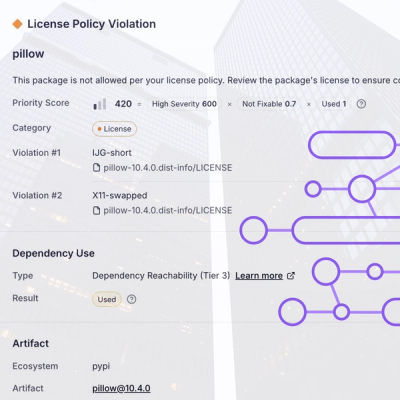
Research
/Security News
Critical Vulnerability in NestJS Devtools: Localhost RCE via Sandbox Escape
A flawed sandbox in @nestjs/devtools-integration lets attackers run code on your machine via CSRF, leading to full Remote Code Execution (RCE).
react-sidebar
Advanced tools
React Sidebar is a sidebar component for React 0.14+. It offers the following features:
The touch interaction of the React Sidebar mimics the interactions that are supported by Android apps that implement the material design spec:
onSetOpen prop if the distance the sidebar was dragged is more than the dragToggleDistance prop.Note: The sidebar touch functionality doesn't work on IOS because of the "swipe-to-go-back" feature. Therefore the functionality has been disabled on IOS.
npm install react-sidebar
If you use TypeScript, typings are available on DefinitelyTyped and can be installed with:
npm install @types/react-sidebar
By design, React Sidebar does not keep track of whether it is open or not. This has to be done by the parent component. This allows the parent component to make changes to the sidebar and main content based on the open/docked state. An example could be to hide the "show menu" button from the main content when the sidebar is docked.
Because React Sidebar can be toggled by dragging the sidebar into its open/closed position, you will have to pass in an onSetOpen method as a prop to allow the sidebar to control the open state in the parent.
The minimum React component to integrate React Sidebar looks like this:
import React from "react";
import Sidebar from "react-sidebar";
class App extends React.Component {
constructor(props) {
super(props);
this.state = {
sidebarOpen: true
};
this.onSetSidebarOpen = this.onSetSidebarOpen.bind(this);
}
onSetSidebarOpen(open) {
this.setState({ sidebarOpen: open });
}
render() {
return (
<Sidebar
sidebar={<b>Sidebar content</b>}
open={this.state.sidebarOpen}
onSetOpen={this.onSetSidebarOpen}
styles={{ sidebar: { background: "white" } }}
>
<button onClick={() => this.onSetSidebarOpen(true)}>
Open sidebar
</button>
</Sidebar>
);
}
}
export default App;
A common use case for a sidebar is to show it automatically when there is enough screen width available. This can be achieved using media queries via window.matchMedia. This again has to be integrated into the parent component so you can use the information to make changes to the sidebar and main content.
import React from "react";
import Sidebar from "react-sidebar";
const mql = window.matchMedia(`(min-width: 800px)`);
class App extends React.Component {
constructor(props) {
super(props);
this.state = {
sidebarDocked: mql.matches,
sidebarOpen: false
};
this.mediaQueryChanged = this.mediaQueryChanged.bind(this);
this.onSetSidebarOpen = this.onSetSidebarOpen.bind(this);
}
componentWillMount() {
mql.addListener(this.mediaQueryChanged);
}
componentWillUnmount() {
this.state.mql.removeListener(this.mediaQueryChanged);
}
onSetSidebarOpen(open) {
this.setState({ sidebarOpen: open });
}
mediaQueryChanged() {
this.setState({ sidebarDocked: mql.matches, sidebarOpen: false });
}
render() {
return (
<Sidebar
sidebar={<b>Sidebar content</b>}
open={this.state.sidebarOpen}
docked={this.state.sidebarDocked}
onSetOpen={this.onSetSidebarOpen}
>
<b>Main content</b>
</Sidebar>
);
}
}
export default App;
| Property name | Type | Default | Description |
|---|---|---|---|
| children | Anything React can render | n/a | The main content |
| rootClassName | string | n/a | Add a custom class to the root component |
| sidebarClassName | string | n/a | Add a custom class to the sidebar |
| contentClassName | string | n/a | Add a custom class to the content |
| overlayClassName | string | n/a | Add a custom class to the overlay |
| sidebar | Anything React can render | n/a | The sidebar content |
| onSetOpen | function | n/a | Callback called when the sidebar wants to change the open prop. Happens after sliding the sidebar and when the overlay is clicked when the sidebar is open. |
| docked | boolean | false | If the sidebar should be always visible |
| open | boolean | false | If the sidebar should be open |
| transitions | boolean | true | If transitions should be enabled |
| touch | boolean | true | If touch gestures should be enabled |
| touchHandleWidth | number | 20 | Width in pixels you can start dragging from the edge when the sidebar is closed. |
| dragToggleDistance | number | 30 | Distance the sidebar has to be dragged before it will open/close after it is released. |
| pullRight | boolean | false | Place the sidebar on the right |
| shadow | boolean | true | Enable/Disable sidebar shadow |
| styles | object | See below | Inline styles. These styles are merged with the defaults and applied to the respective elements. |
| rootId | string | n/a | Add an id to the root component |
| sidebarId | string | n/a | Add an id to the sidebar |
| contentId | string | n/a | Add an id to the content. The driving use case for adding an element id to content was to allow react-scroll to scroll the content area of the site using react-sidebar. |
| overlayId | string | n/a | Add an an id to the overlay |
Styles are passed as an object with 5 keys, root, sidebar, content, overlay and dragHandle, and merged to the following defaults:
{
root: {
position: "absolute",
top: 0,
left: 0,
right: 0,
bottom: 0,
overflow: "hidden"
},
sidebar: {
zIndex: 2,
position: "absolute",
top: 0,
bottom: 0,
transition: "transform .3s ease-out",
WebkitTransition: "-webkit-transform .3s ease-out",
willChange: "transform",
overflowY: "auto"
},
content: {
position: "absolute",
top: 0,
left: 0,
right: 0,
bottom: 0,
overflowY: "auto",
WebkitOverflowScrolling: "touch",
transition: "left .3s ease-out, right .3s ease-out"
},
overlay: {
zIndex: 1,
position: "fixed",
top: 0,
left: 0,
right: 0,
bottom: 0,
opacity: 0,
visibility: "hidden",
transition: "opacity .3s ease-out, visibility .3s ease-out",
backgroundColor: "rgba(0,0,0,.3)"
},
dragHandle: {
zIndex: 1,
position: "fixed",
top: 0,
bottom: 0
}
};
My goal was to make a React Component that implements the material design spec for navigation drawers. My initial attempt was to improve hamburger-basement by arnemart but I quickly figured that I better start from scratch. Still, that project helped me a ton to get started.
FAQs
Did you know?

Socket for GitHub automatically highlights issues in each pull request and monitors the health of all your open source dependencies. Discover the contents of your packages and block harmful activity before you install or update your dependencies.

Research
/Security News
A flawed sandbox in @nestjs/devtools-integration lets attackers run code on your machine via CSRF, leading to full Remote Code Execution (RCE).

Product
Customize license detection with Socket’s new license overlays: gain control, reduce noise, and handle edge cases with precision.

Product
Socket now supports Rust and Cargo, offering package search for all users and experimental SBOM generation for enterprise projects.